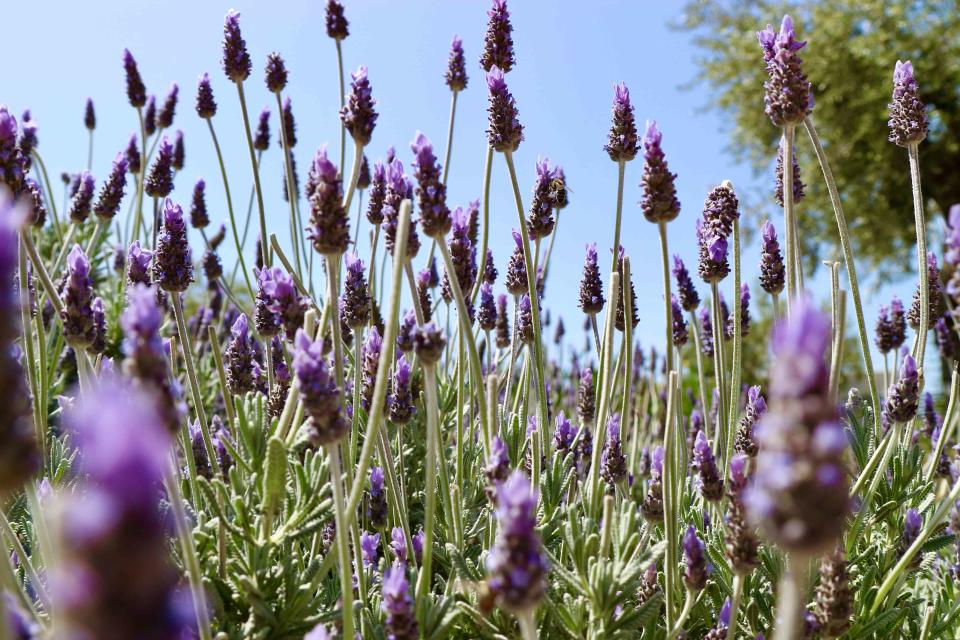French Lavender: How To Grow and Care for It in Your Yard
This calming plant can actually blossom in many front yards with proper care.

Kosta Nikolopoulos/Getty Images
French lavender, or Lavandula dentata, is a beautiful flowering plant known for its calming, soothing scent and pastel purple blooms. These native Mediterranean plants are popular in gardens throughout the world. French lavender's signature calming scent is often used in essential oils and perfumes. Although French lavender is also sometimes a nickname for another type of lavender, Lavandula stoechas, in the U.S., it’s most commonly used to describe Lavandula dentata.
Unlike other lavender plants, French lavender has leaves with scalloped, serrated edges and a textured, gray-green color. This fringed look makes the plant stand out from other lavender varieties. French lavender does well in sunny, dry conditions and is resilient, even tolerating neglect, but there are a few care requirements for the purple beauties. Here's how to grow and maintain French lavender in your own front yard.
Related: 34 Drought-Tolerant Plants That Will Improve Your Home's Curb Appeal
Meet Our Expert
Michele Chambliss, ASHS-certified Horticulturist and Garden Designer
Nathan Heinrich, Horticulturist and Landscape Designer
Growing Conditions
French lavender flourishes in sunny, dry conditions with alkaline soil. The plants need well-draining soil and plenty of sunshine. The pastel purple blooms appear year-round in warm climates and from spring to fall in cooler temperatures.
“The hottest, sunniest corner of your yard is where lavender will be happiest,” says horticulturist and landscape designer Nathan Heinrich. “Lavender does not need shade, but it can tolerate morning shade as long as it gets plenty of sun during the afternoon hours.”
“With the right care, annual pruning, full sun, and minimal watering, lavender plants can easily live up to 15 years or longer,” Heinrich says. French lavender is a hardy plant that can last years in sunny, dry conditions.
Soil and Fertilization
When planting French lavender, use neutral or alkaline soil with poor nutrients. French lavender does not do well in nutrient-rich soil, so fertilization is unnecessary. If you’re concerned that your soil needs more drainage, add gravel mulch to the top of your soil.
Plant your French lavender in the spring, before summer’s heat, but after winter frost. You can also plant French lavender in the fall if you live in a mild climate with warm winters.
Water
Since these purple plants do best with dry conditions, you only need to water newly planted French lavender once every few weeks until blooms appear. The greatest threat to French lavender is root rot, so avoid overwatering and plant your lavender in dry, well-draining soil.
“Overwatering in the summer is definitely something to avoid,” says garden designer Michele Chambliss, an ASHS-certified horticulturist. “In areas with higher rainfall, planting on a berm with a gravel mulch might help with drainage. Lavender roots sitting in warm, wet soil may rot.”
Once your plants are established and blooming, you will not need to water them unless you have extreme heat and drought.
Pruning Tips
“Besides yearly pruning, lavender plants of all varieties can be completely neglected and will continue to flower and thrive year after year,” Heinrich says. French lavender requires an annual pruning to keep your plants looking their best. If you live in a temperate climate with cold winters, prune your plants in early spring. For warm temperatures with year-round blooms, prune in late summer to early fall.
“In mild climates, French lavender can bloom year-round,” Heinrich says. “This can make it slightly confusing about when you should prune. However, mid-August to early September, at the end of the summer growing season, when the weather has started to cool down, is the perfect time for pruning.”
Heinrich advises cutting plants back to about knee height or to the point on the stem where the gray-green stems and shoots become brown and dead-looking. If your lavender has healthy-looking growth down to the roots, with no brown or dead-looking portion of the stem, cut the plant back by half its current size. Refrain from making drastic cuts because French lavender will not grow back from old wood.
Common Pests and Diseases
French lavender is hardy and resistant to many pests. Overwatering and damp, humid conditions can lead to root rot, so water sparingly and only when you first plant your lavender or in extreme heat and drought. If your lavender’s leaves are wilted, drooping, or yellow, cut down on your watering and allow the soil to dry out.
Powdery mildew is another issue that can arise for French lavender in humid climates or with wet soil. Ensure you have well-draining soil and avoid overwatering to prevent powdery mildew. If your plants have a white or gray dusting on the leaves, use an organic fungicide or neem oil to eliminate powdery mildew.
“French lavender can become susceptible to springtime aphids, which in my experience can be hosed off with a strong stream of water until the beneficial insects show up and make a quick meal of them,” Chambliss says. “I think it’s worth the extra trouble getting the soil and situation just right to have the amazing fragrance and beauty of French lavender in our gardens.”
Related: 8 Flowering Bushes to Boost Curb Appeal
For more Real Simple news, make sure to sign up for our newsletter!
Read the original article on Real Simple.

